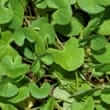Background
- Gotu kola is from the perennial creeping plant, Centella asiatica (formerly known as Hydrocotyle asiatica), which is a member of the parsley family. It is native to India, Madagascar, Sri Lanka, Africa, Australia, China, and Indonesia.
- Gotu kola has a long history of use, dating back to ancient Chinese and Ayurvedic medicine. Gotu kola is mentioned in the Shennong Herbal, compiled in China roughly 2,000 years ago, and has been widely used medicinally since 1700 AD. It has been used to treat leprosy in Mauritius since 1852; to treat wounds and gonorrhea in the Philippines; and to treat fever and respiratory infections in China.
- The most popular use of gotu kola in the United States is the treatment for varicose veins or cellulitis. Preliminary evidence suggests short-term efficacy (6-12 months) of the total triterpenic fraction of Centella asiatica (TTFCA) in the treatment of "chronic venous insufficiency" (a syndrome characterized by lower extremity swelling, varicosities, pain, itching, atrophic skin changes, and ulcerations, possibly due to venous valvular incompetence or a post-thrombotic syndrome).
- While quality human evidence on the efficacy of gotu kola is still lacking, gotu kola can now be found worldwide as a component of skin creams, lotions, hair conditioners, shampoos, tablets, drops, ointments, powders, and injections. Gotu kola is not related to the kola nut (Cola nitida, Cola acuminata). Gotu kola is not a stimulant and does not contain caffeine.
References
Natural Standard developed the above evidence-based information based on a thorough systematic review of the available scientific articles. For comprehensive information about alternative and complementary therapies on the professional level, go to . Selected references are listed below.
- Belcaro G, Laurora G, Cesarone MR, et al. Efficacy of Centellase (R) in the treatment of venous hypertension evaluated by a combined microcirculatory model. Curr Ther Res 1989;46(6):1015-1026.
- Belcaro GV, Grimaldi R, Guidi G, et al. Treatment of diabetic micorangiopathy with TTFCA. A microcirculatory study with laser-Doppler flowmetry, P02/PC02, and capillary permeability measurements. Curr Ther Res 1990;47(3):421-428.
- Belcaro GV, Rulo A, Grimaldi R. Capillary filtration and ankle edema in patients with venous hypertension treated with TTFCA. Angiology 1990;41(1):12-18.Belcaro GV, Grimaldi R, Guidi G. Improvement of capillary permeability in patients with venous hypertension after treatment with TTFCA. Angiology 1990;41(7):533-540.
- Bradwejn J, Zhou Y, Koszycki D, et al. A double-blind, placebo-controlled study on the effects of Gotu Kola (Centella asiatica) on acoustic startle response in healthy subjects. J Clin Psychopharmacol 2000;20(6):680-684.
- Carlson JJ, Farquhar JW, DiNucci E, et al. Safety and efficacy of a ginkgo biloba-containing dietary supplement on cognitive function, quality of life, and platelet function in healthy, cognitively intact older adults. J Am Diet.Assoc 2007;107(3):422-432.
View Abstract - Cesarone MR, Incandela L, De Sanctis MT, et al. Evaluation of treatment of diabetic microangiopathy with total triterpenic fraction of Centella asiatica: a clinical prospective randomized trial with a microcirculatory model. Angiology 2001;52(10 suppl 2):S49-S54.
View Abstract - Cesarone MR, Incandela L, De Sanctis MT, et al. Flight microangiopathy in medium- to long-distance flights: prevention of edema and microcirculation alterations with total triterpenic fraction of Centella asiatica. Angiology 2001;52(10 suppl 2):S33-S37.
View Abstract - Cesarone MR, Belcaro G, De Sanctis MT, et al. Effects of the total triterpenic fraction of Centella asiatica in venous hypertensive microangiopathy: a prospective, placebo-controlled, randomized trial. Angiology 2001;52(10 suppl 2):S15-S18.
View Abstract - De Sanctis MT, Belcaro G, Incandela L, et al. Treatment of edema and increased capillary filtration in venous hypertension with total triterpenic fraction of Centella asiatica: A clinical, prospective, placebo-controlled, randomized, dose-ranging trial. Angiology 2001;52(10 suppl 2):S55-S59.
View Abstract - Incandela L, Belcaro G, De Sanctis MT, et al. Total triterpenic fraction of Centella asiatica in the treatment of venous hypertension: a clinical, prospective, randomized trial using a combined microcirculatory model. Angiology 2001;52(10 suppl 2):S61-S67.
View Abstract - Incandela L, Cesarone MR, Cacchio M, et al. Total triterpenic fraction of Centella asiatica in chronic venous insufficiency and in high-perfusion microangiopathy. Angiology 2001;52(10 suppl 2):S9-S13.
View Abstract - Incandela L, Belacaro G, Cesarone MR, et al. Treatment of diabetic microangiopathy and edema with total triterpenic fraction of Centella asiatica: a prospective, placebo-controlled randomized study. Angiology 2001;52(10 suppl 2):S27-S31.
View Abstract - Kaziulin AN, Petukhov AB, Kucheriavyi IuA. [Efficiency of includes of bioactive substances in diet of patient with hepatic encephalopathy]. Vopr.Pitan. 2006;75(2):40-44.
View Abstract - Ramanathan M, Sivakumar S, Anandvijayakumar PR, et al. Neuroprotective evaluation of standardized extract of Centella asciatica in monosodium glutamate treated rats. Indian J Exp Biol 2007;45(5):425-431.
View Abstract







